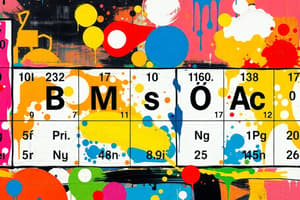Podcast
Questions and Answers
Which of the following is a characteristic of a pure substance?
Which of the following is a characteristic of a pure substance?
- Components can be easily separated by physical means.
- Has unique physical and chemical properties. (correct)
- Made up of more than one type of matter.
- Physically combined components.
Mixtures, by definition, are pure substances.
Mixtures, by definition, are pure substances.
False (B)
What type of substance is composed of only one kind of atom?
What type of substance is composed of only one kind of atom?
element
Elements are in fixed amounts, written as formulas with numbers as ________.
Elements are in fixed amounts, written as formulas with numbers as ________.
Match the following terms with their correct descriptions.
Match the following terms with their correct descriptions.
In a solution of salt water, which component is considered the solvent?
In a solution of salt water, which component is considered the solvent?
Alloys are examples of liquid-metal solutions.
Alloys are examples of liquid-metal solutions.
What term describes liquids that do not mix, such as oil and water?
What term describes liquids that do not mix, such as oil and water?
The liquid collected during filtration is called the ________.
The liquid collected during filtration is called the ________.
Which separation technique involves a substance changing from liquid to gas?
Which separation technique involves a substance changing from liquid to gas?
Flashcards
Pure substance
Pure substance
Made up of only one type of matter (element or compound).
Impure substance/Mixture
Impure substance/Mixture
Made up of more than one type of matter physically combined.
Element
Element
Made up of only one kind of atom.
Compound
Compound
Signup and view all the flashcards
Homogenous mixture
Homogenous mixture
Signup and view all the flashcards
Heterogenous Mixture
Heterogenous Mixture
Signup and view all the flashcards
Filtrate
Filtrate
Signup and view all the flashcards
Residue
Residue
Signup and view all the flashcards
Evaporation
Evaporation
Signup and view all the flashcards
Distillation
Distillation
Signup and view all the flashcards
Study Notes
Chemistry Unit 4: Elements, Compounds, Mixtures
- Refer to pages 2.34-2.45 of notebook, Obj.4.a Slides.
- Refer to pages 2.30-2.32 of notebook for phenomenon.
Pure Substances
- Pure substances comprise of one type of matter (element or compound).
- A pure substance will have unique physical and chemical properties like melting/boiling points, density, and hardness.
Impure Substances
- Impure substances consist of more than one type of matter physically combined.
- Physical properties of pure substances in the mixture can separate them.
Elements
- Elements consist of only one kind of atom.
- Some elements exist as diatomic molecules.
- Examples of elements from group 7 (halogens) include H₂, O₂, N₂.
- Elements identified by a chemical symbol.
Compounds
- Compounds consist of two or more different elements.
- Elements are chemically bonded.
- The elements are in fixed amounts.
- Formulas are used, with numbers as subscripts, to write elements.
Mixtures - Homogenous (Solutions)
- Refer to page 2.35 for more examples
- Homogenous mixtures look uniform throughout.
- Solutions are made of solvents and solutes.
- Solvents are usually present in large amounts, typically liquid (like water).
- Solutions in water are aqueous, denoted by the symbol (aq).
- Solutes are present in smaller amounts and dissolve.
- Alloys are solid metal solutions.
- Air is a solution of gasses.
- N₂ is the solvent; O₂, CO₂, H₂O, etc., are solutes.
Dissolving Ionic Substances vs. Covalent Substances (like Sugar) in Water
Ionic Substances:
- Water molecules interact with the substance:
- If soluble, water molecules overcome ionic attractions within the lattice.
- Solvated ions move off the surface and separate in the solution.
- Water molecules cluster around anions:
- Positive hydrogens bond to negative anions.
- Negative oxygen bonds to positive cations.
Covalent Substances:
- Water molecules arrange around the substance according to opposite polar areas.
- The attraction of water molecules/motion overcomes the attraction between the molecules.
- Molecules dissolve because they are separated from each other and mixed in with water.
Mixtures - Heterogeneous (Suspensions)
- Adding a solid to water turns it "cloudy".
- If left alone, solid particles precipitate out and settle out to the bottom.
- Heterogeneous mixtures do not look uniform throughout; particles can usually be seen.
- Example: chocolate chip cookies.
- Suspensions: examples of heterogeneous mixtures in a liquid.
- If left to stand, suspended particles may separate, settle, or precipitate out.
- Particles do not dissolve (insoluble), like medicines or drinks that say "shake well before use".
- Immiscible: when liquids (like oil and water) do not mix.
Examples of Homogenous vs. Heterogeneous Mixtures
Homogenous:
- lemonade
- tea w/ sugar
- salt water
- milk
- ketchup
- paint
- these are the same throughout
Heterogenous:
- gravel
- chocolate chip cookies
- soda (w/ carbonation)
- fruit yogurt
- buttered popcorn
- crayons (wrapped in paper)
- salad
- chicken noodle soup
- these are not the same throughout
- Refer to page 2.44 for particle/substance info.
- Refer to pages 2.38-2.40 for more phenomenon examples.
Separations - Filtration
- Separations (pages 2.46-2.47 of notebook, Obj.4.b Slides)
- Used to separate a suspension (heterogeneous mixture).
- Method depends on properties of the substance to be collected.
Common properties include:
- Particle size (big or small): soluble vs. insoluble.
- Boiling point: temperature to change from liquid to gas.
- Solubility: whether it dissolves in a specific solvent or not.
- Density: whether it is likely to float or sink in a solvent.
- One can collect material in the residue and/or filtrate.
- Insoluble substances (that don't dissolve) won't pass through pores (holes) in the filter paper.
- The solid trapped on filter paper is the residue.
- Soluble substances (that dissolve) pass through the paper with the solvent.
- The liquid collected is the filtrate (collected by another method if needed).
Separations - Evaporation
- Evaporation is used to separate a solution (homogenous mixture).
- One can only collect the solute (dissolved solid) in evaporation.
- Solvent evaporates (changes from liquid to gas), leaving behind the solid (can be scraped off).
Separations - Distillation
- Distillation is used to separate a solution (homogenous mixture).
- One can only collect solvent (liquid) in distillation.
- The mixture is heated.
- Lower boiling point liquid gains enough energy to evaporate.
- Gas is cooled and condenses into pure liquid.
- The condenser is always cold (gas condenses back to liquid).
- The solid is left in the original beaker, and the liquid is in a new beaker.
Studying That Suits You
Use AI to generate personalized quizzes and flashcards to suit your learning preferences.





